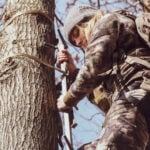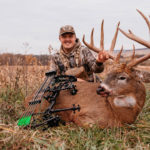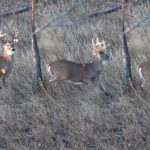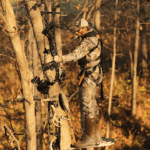There was a time when deer hunters cared very little about the amount of bone on top of a deer’s head. For the most part, a hunter would shoot the first buck that walked out.
However, that’s all changed over the last three decades. Nowadays, more and more hunters are pursuing the biggest buck on the farm. The Quality Deer Management efforts showed hunters what could be done on the properties they were hunting. It led to better quality deer herds as a whole.
That’s why knowing how to age a buck on the hoof is so important. Knowing the age of deer is a great tool in your management and conservation efforts. Below you’ll find an in-depth look at how to age white-tailed bucks.
1.5 Year-Old Bucks
Description:
The 1 1/2 year old buck is one of the easiest to identify. If he looks like a sleek and slim doe with antlers, it’s likely a yearling buck. His features include a thin neck, legs, and hindquarters.
He’ll have a carefree attitude, acting less cautious, and often oblivious to the dangers around him. You typically find this buck still hanging out with doe groups, with other 1 1/2 year old bucks, or by themselves.
View More 1.5 Year Old Bucks Below:
2.5 Year-Old Bucks
Description:
The 2 1/2 year old buck will begin to add muscle to his body, but will continue to maintain a flat belly line, slightly thicker hindquarters, long lanky legs, and limited neck swelling during the rut.
Antlers on the 2 1/2 year old buck will typically grow to 6 or 8 points in their thin and narrow rack. Biologist say that a buck will display 40%-60% of antler potential at 2 1/2 years old.
View More 2.5 Year Old Bucks Below:
3.5 Year-Old Bucks
Description:
The 3 1/2 year old buck will make a noticeable change in body size from the previous year with a stocky build and set of antlers that’ll likely catch your attention and make you look twice. Look closer and you’ll typically see that antler width on this buck has grown to equal the width of his ears.
His antlers are roughly at 60% – 75% of their potential at this point. His neck is larger this year, but the necks still distinctly stands apart from the chest and brisket. Bucks at this age will typically have a flat belly and no sway across their back.
View More 3.5 Year Old Bucks Below:
4.5 Year-Old Bucks
Description:
The 4 1/2 year old buck is what most hunters consider a shooter. He’s grown to 80% – 90% of his antler potential at this point and by most standards is considered, mature.
The buck’s neck is bulky and muscled now, blending smoothly into the chest and shoulders. His waist line likely drops deep into his chest and you’ll likely notice a slight sag across his back.
View More 4.5 Year Old Bucks Below:
5.5 Year-Old Bucks
Description:
The 5 1/2 year old buck has reached maximum antler size. His bulky upper body will typically make his legs appear short and stubby. The front of half of his body appears to be one large mass with a smooth transition from neck to chest and shoulders.
You’ll quickly notice his strikingly large neck, sagging belly and sway back. You’ll often find battle scars on around the face, ears, and neck of a buck in this age class. Regardless of antler size, the 5 1/2 year old buck is an absolute trophy for any hunter.
View More 5.5 Year Old Bucks Below:
Bucks 6.5 & Older
The buck that makes it to 6 1/2 years of age, and beyond, is a rare breed throughout much of the country. He’s a true warrior, having survived well beyond what statistics say he should. At 6 1/2, his antlers may still be his crowning glory.
However, in the years to follow, antler decline will be evident. He’ll begin to look and act like an old man, moving slowly, traveling less, and maintaining a sagging physical build.
“Bucks that have made it to their 6th season will certainly (well, usually) have neck and shoulders that are hard to tell where one begins and one ends,” says Dr. Bronson Strickland, Professor at the MSU Deer Lab. “That is, there’s no clear distinction between ‘this is the neck’ and ‘this is the shoulder.’ It’s like they overlap. The belly should be fully developed and maybe sagging a little. The brisket seems to move when the buck walks. Also, tarsal staining should be running down back of the leg.”
Strickland also mentions that there’s really not much antler decline at 6.5 and most likely no antler decline until 9.5 or 10.5 unless the buck has an injury, disease, or food availability is diminished.
View More 6.5+ Year Old Bucks Below:
What Ages are the Hardest to Tell Apart?
It’s obviously helpful for a hunter to know the age of a buck to aid in the effort of maximizing potential. But this can be tough in those years where there may not be as much visible change.
What ages are the hardest to tell apart?
Dr. Strickland gives us some great insight here as well.
“Personally, I think 3.5 to 4.5 is the most difficult, but others in the lab think 4.5 to 5.5. So 3.5 vs 4.5 and 4.5 vs 5.5 can be challenging. Some bucks “follow the script” and develop as you would predict – neck/shoulder development, sagging belly, etc. But others may lag behind, and others may develop more quickly based on genetics and/or resource availability. It’s very important to find growth patterns that are reliable in your area. For example, when I go from Mississippi to South Texas, I need a refresher course and spend some time with someone experienced in that area to show me the characteristics they look for.”
Wrapping Up
As stated above, having the know-how to age deer on the hoof will greatly increase your ability to grow deer to full potential. The key is to slow down, look closer, and know what you’re pulling the trigger on.
There will be times when you are fooled and ground shrinkage bites you bad. But as you develop your buck aging skills, you’ll quickly see a shift in the size of the bucks you grow on your property, as well as the ones you wrap your tag around.

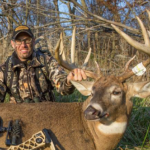 By
By 